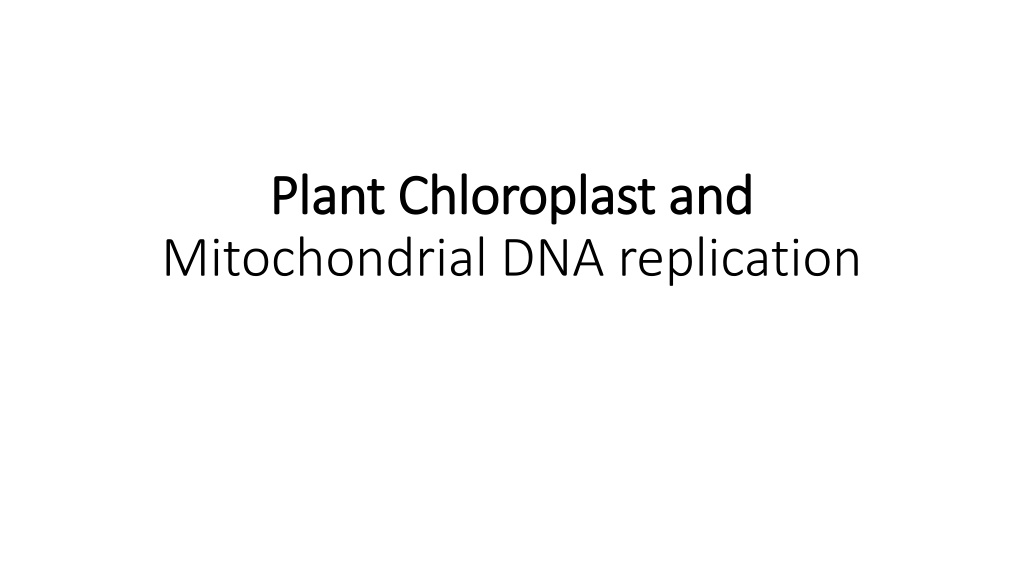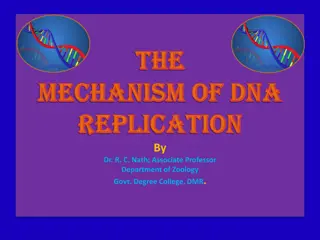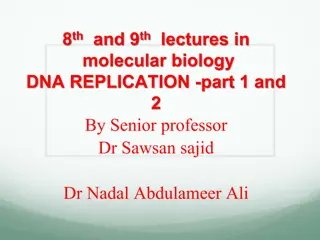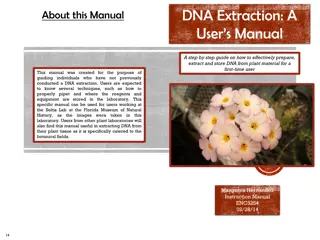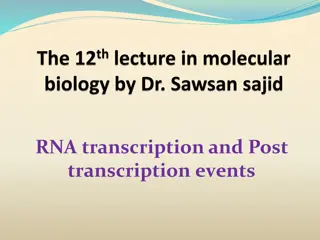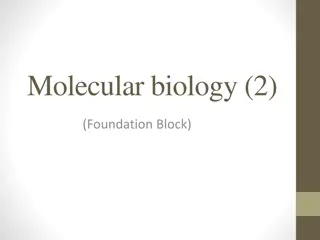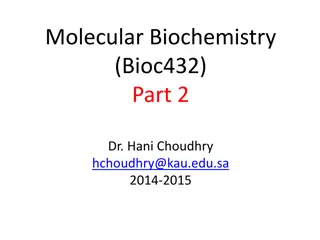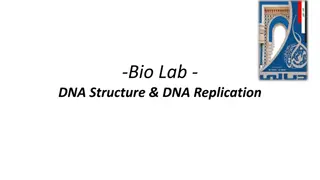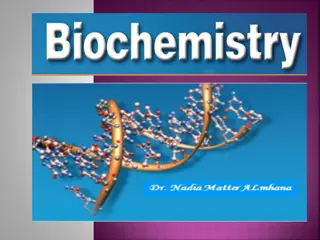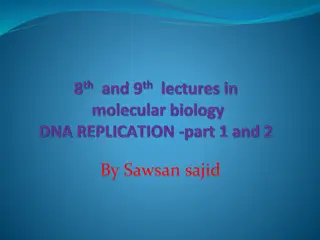Plant Mitochondrial and Chloroplast DNA Replication Mechanisms
Plant mitochondria and chloroplasts have intricate DNA replication processes. Mitochondrial DNA replication is independent of the plant cell cycle and is associated with specific proteins in nucleoid complexes. Plant mtDNA contains more genes than animal mtDNA, with a complex structure involving introns and repeats. Plant cpDNA replication utilizes a double displacement loop strategy, while rolling circle replication is observed in both mitochondria and chloroplasts.
Download Presentation

Please find below an Image/Link to download the presentation.
The content on the website is provided AS IS for your information and personal use only. It may not be sold, licensed, or shared on other websites without obtaining consent from the author. Download presentation by click this link. If you encounter any issues during the download, it is possible that the publisher has removed the file from their server.
E N D
Presentation Transcript
Plant Chloroplast and Plant Chloroplast and Mitochondrial DNA replication
Mitochondrial DNA replication MtDNA replication is not directly linked to the plant cell cycle, and mtDNA copy numbers can vary widely depending on the tissue and stage of development. MtDNA has been shown to be associated with specific proteins that form nucleoid complexes within the mitochondrial matrix. In contrast to animals, plant mtDNA contains many more genes and plant mitochondrial genomes are much larger. Large portions of AT-rich non-coding or undefined DNA. A typical plant mitochondrial genome encodes anywhere between 50 and 100 genes. The large genome size is at least partially due to the presence of non-coding DNA sequences, which consist of introns, repeats, and duplications of regions of the genome. The known genes encode rRNA and tRNA genes as well as subunits for oxidative phosphorylation chain complexes. The presence of these large non-coding DNA may have a role in lowering the mutation rate
Plant Mitochondria Plants most likely employ multiple mechanisms for replication of the mtDNA due to the complex structure of the mitochondrial genome. The structure of plant mtDNA makes strand displacement (D-loop) replication implausible, although there is one report of this mechanism observed in petunia flowers. Rolling circle replication and recombination-dependent replication have also been observed in Chenopodium album, suggesting it could be a common replication mode in other plant species as well
Plant Chloroplasts Replication Plant Chloroplasts Replication Plant Chloroplasts Replication of cpDNA is better understood than plant mitochondrial DNA replication. Chloroplasts utilize a double displacement loop strategy to initiate DNA replication. The two displacement loops begin on opposite strands and begin replicating unidirectionally towards each other until they join to create a bidirectional replication bubble. DNA replication continues bidirectionally until two daughter molecules are created. Rolling circle and recombination-dependent replication have also been proposed for cpDNA. Chloroplast genomes exist primarily as homogeneous closed circle DNA molecules.
Replication mechanisms of mitochondrial and Replication mechanisms of mitochondrial and Chloroplasts DNA. Chloroplasts DNA. Rolling circle DNA replication is initiated by an initiator protein, which nicks one strand of the double-stranded, circular DNA molecule at a site called the double- strand origin (DSO). The initiator protein remains bound to the 5' phosphate end of the nicked strand, and the free 3' hydroxyl end is released to serve as a primer for DNA synthesis by DNA polymerase. Using the unnicked strand as a template, replication proceeds around the circular DNA molecule, displacing the nicked strand as single-stranded DNA. Displacement of the nicked strand is carried out by a helicase Continued DNA synthesis can produce multiple single-stranded linear copies of the original DNA in a continuous head-to-tail series called a concatemer(A concatemer is a long continuous DNA molecule that contains multiple copies of the same DNA sequence linked in series. These polymeric molecules are usually copies of an entire genome linked end to end and separated by cos sites). These linear copies can be converted to double-stranded circular molecules through the following process: First, the initiator protein makes another nick in the DNA to terminate synthesis of the first (leading) strand. RNA polymerase and DNA polymerase then replicate the single-stranded origin (SSO) DNA to make another double-stranded circle. The rolling replication is observed In Chenopodium album
As a summary, a typical DNA rolling circle replication has five steps: Circular dsDNA will be "nicked". The 3' end is elongated using "unnicked" DNA as leading strand (template); 5' end is displaced. Displaced DNA is a lagging strand and is made double stranded via a series of Okazaki fragments. Replication of both "unnicked" and displaced ssDNA. Displaced DNA circularizes.
D-loop replication is a proposed process by which circular DNA like chloroplasts and mitochondria replicate their genetic material. An important component of understanding D-loop replication is that many chloroplasts and mitochondria circular chromosome like linear chromosomes found many chloroplasts and mitochondria have a linear chromosome, and D- loop replication is not important in these organelles. Also, not all circular genomes use D-loop replication as the process of replicating its genome. In many organisms, one heavier nucleotides (relatively more purines: adenine and guanine). This strand is called the H (heavy) strand. The L (light) strand comprises lighter nucleotides (pyrimidines: thymine and cytosine). Replication begins with replication of the heavy strand starting at the D-loop. have instead eukaryotes. a single the bacteria in of However, strand of DNA comprises
Each D-loop contains an origin of replication for the heavy strand. Full circular DNA replication is initiated at that origin and replicates in only one direction. The middle strand in the D-loop can be removed and a new one will be synthesized that is not terminated until the heavy strand is fully replicated. As the heavy strand replication reaches the origin of replication for the light strand, a new light strand will be synthesized in the opposite direction as the heavy strand. There is more than one proposed process through which D-loop replication occurs, but in all of the models, these steps are agreed upon. The portions not agreed upon are what is the importance of maintaining a D-loop when replication is not in progress, because it is energetically expensive to the cell, and what mechanisms, during replication, preserve the detached strand of DNA that is waiting to be replicated.
To date, two organellar DNA polymerases, Poly I-A and Poly I-B, resembling bacterial DNA Poly I, have been discovered in both mitochondria and chloroplasts. Although Poly I-A and Poly I-B are similar to each other, notable differences between the two have been observed. Poly I-B knockout plants were shown to have fewer genome copy numbers per organelle and grew slowly, a predominant role of Poly I-B in cpDNA damage repair. Recent studies show that Poly I-A replicates DNA with high fidelity. heterozygous plants containing a single copy of either Poly I-A or Poly I-B were able to grow to maturity Structural analysis of these DNA polymerases indicate that they are distinct from the animal mtDNA polymerase gamma and other animal nuclear DNA polymerases, and that they show the greatest phylogenetic relationship with bacterial Poly I.
primase preferentially incorporates CTP and GTP, which is curious as nearly all plant mitochondrial and chloroplast genomes are highly A/T rich. Why then would a plant organellar primase preferentially incorporate CTP and GTP? This G C rich sequence is hypothesized to provide stability during primer extension Unlike animal mitochondria, which utilize a single RNA polymerase [primase], plant organelles require multiple RNAPs: at least two for plastids and one for mitochondria. In Some plants the activity of helicase and primase is accomplished by one complex (Twinkle). Twinkle mutant plants have no clear phenotype, indicating that in contrast to the role of Twinkle in animal mitochondria, there is no absolute requirement for this gene in Arabidopsis. In humans there is a second DNA helicase, DNA2 nuclease/helicase, localized to the nucleus and mitochondria
In E. coli, RNA primers are removed from DNARNA hybrids by the 5-3 exonuclease activity of DNA polymerase I. Since Poly I-A and Poly I-B lack 5 -3 exonuclease activity, primer removal must be carried out by another enzyme. Recent work has shown RNase H-like activity both in mitochondria and chloroplasts Plants utilize at least two types of single stranded DNA binding proteins (SSBs) in their organelles. The first one is similar to bacterial SSBs. Arabidopsis encodes at least two of these genes, called SSB1 and SSB2, although little is known about SSB2. The second class of SSB proteins is called organellar single-stranded DNA binding proteins (OSB). OSB proteins are distinct from the bacterial SSB versions and are unique to plant organelles. four OSB genes are transcribed in Arabidopsis with OSB proteins localizing to both the mitochondria and chloroplasts. organellar single-stranded DNA binding proteins (OSB) These proteins are unique to plant organelles.
